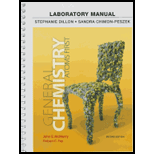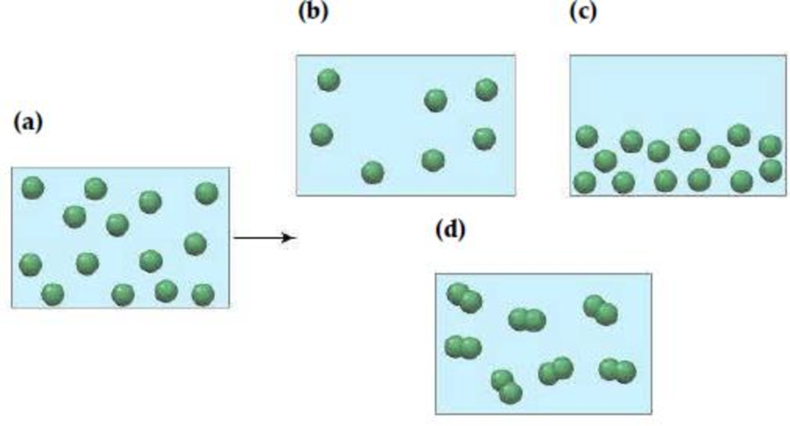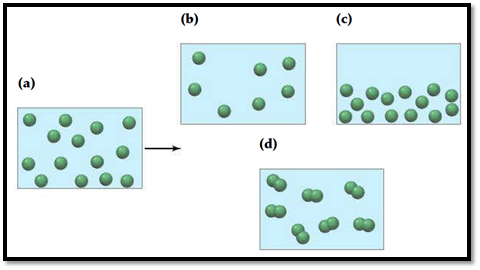
Box (a) represents 1.0 mL of a solution of particles at a given concentration. Which of the boxes (b)–(d) represents 1.0 mL of the solution that results after (a) has been diluted by doubling the volume of its solvent?

Interpretation:
Among the given boxes (b)-(d), the box that represents the result of box (a) after being diluted with double the volume of its solvent has to be identified.
Concept Introduction:
Diluting Concentrated Solutions:
On diluting concentrated solutions, the product of molarity and volume of an initial solution will be equal to the product of molarity and volume of a final solution and hence the number of moles of solute remains constant.
Where,
Answer to Problem 6.30CP
The box that gives the result of box (a) after dilution is box (b)
Explanation of Solution
Given data:
The given box (a) and the optional boxes (b)-(d) which forms the result of dilution of box (a) are shown in the below figure 1.

Figure 1
Box (a) represents
Box (b)-(d) represents
Reason for correct option:
The correct option that results after dilution is box (b)
The green spheres in each box represents, the number of particles present in it which in turn corresponds to the concentration of each solution.
- Box (a) contains 14 green spheres representing the concentration of solution contained in it.
- Box (b) contains 7 green spheres representing the concentration of solution contained in it.
When the volume of a solution is doubled, the concentration is halved.
Hence, box (b) represents half the concentration of box (a) that is 7 green spheres which is half of 14 spheres.
Therefore, the correct option is box (b)
Reason for incorrect options:
Box (c) contains 14 green spheres. This implies that the concentration remains same even after dilution. But in actual after doubling the volume, concentration will be halved.
Box (d) represents formation of molecules which will not happen in actual on dilution.
Hence, the incorrect options are box (c) and box (d).
The box that represents the result of box (a) after being diluted with double the volume of its solvent was identified as box (b)
Want to see more full solutions like this?
Chapter 6 Solutions
General Chemistry: Atoms First -Laboratory Manual
- Twenty-five mL of a 0.388 M solution of Na2SO4 is mixed with 35.3 mL of 0.229 M Na2SO4. What is the molarity of the resulting solution? Assume that the volumes are additive.arrow_forwardWhat is the difference between a solute and a solvent?arrow_forwardDetermine the volume of sodium hydroxide solution needed to prepare 26.2 g sodium phosphate, Na3PO4, by the reaction 3NaOH(aq)+H3PO4(aq)Na3PO4(aq)+3H2O(l) The sodium hydroxide solution, whose density is 1.133 g/mL, contains 12.0% NaOH by mass.arrow_forward
- A student wants to prepare 1.00 L of a 1.00-M solution of NaOH (molar mass = 40.00 g/mol). If solid NaOH is available, how would the student prepare this solution? If 2.00 M NaOH is available, how would the student prepare the solution? To help ensure three significant figures in the NaOH molarity, to how many significant figures should the volumes and mass be determined?arrow_forwardYou wish to prepare 1 L of a 0.02-M potassium iodate solution. You require that the final concentration be within 1% of 0.02 M and that the concentration must be known accurately to the fourth decimal place. How would you prepare this solution? Specify the glassware you would use, the accuracy needed for the balance, and the ranges of acceptable masses of KIO3 that can be used.arrow_forwardDetermine the volume of sulfuric acid solution needed to prepare 37.4 g of aluminum sulfate, Al2(SO4)3, by the reaction 2Al(s)+3H2SO4(aq)Al2(SO4)3(aq)+3H2(g) The sulfuric acid solution, whose density is 1.104 g/mL, contains 15.0% H2SO4 by mass.arrow_forward
- A student weighs out a 4.80-g sample of aluminum bromide, transfers it to a 100-mL volumetric flask, adds enough water to dissolve it, and then adds water to the 100-mL mark. What is the molarity of aluminum bromide in the resulting solution?arrow_forwardBone was dissolved in hydrochloric acid, giving 50.0 mL of solution containing calcium chloride, CaCL2. To precipitate the calcium ion from the resulting solution, an excess of potassium oxalate was added. The precipitate of calcium oxalate, CaC2O4, weighed 1.437 g. What was the molarity of CaCl2 in the solution?arrow_forward
 Chemistry: Principles and ReactionsChemistryISBN:9781305079373Author:William L. Masterton, Cecile N. HurleyPublisher:Cengage Learning
Chemistry: Principles and ReactionsChemistryISBN:9781305079373Author:William L. Masterton, Cecile N. HurleyPublisher:Cengage Learning Introductory Chemistry: A FoundationChemistryISBN:9781337399425Author:Steven S. Zumdahl, Donald J. DeCostePublisher:Cengage Learning
Introductory Chemistry: A FoundationChemistryISBN:9781337399425Author:Steven S. Zumdahl, Donald J. DeCostePublisher:Cengage Learning ChemistryChemistryISBN:9781305957404Author:Steven S. Zumdahl, Susan A. Zumdahl, Donald J. DeCostePublisher:Cengage Learning
ChemistryChemistryISBN:9781305957404Author:Steven S. Zumdahl, Susan A. Zumdahl, Donald J. DeCostePublisher:Cengage Learning
 Chemistry: An Atoms First ApproachChemistryISBN:9781305079243Author:Steven S. Zumdahl, Susan A. ZumdahlPublisher:Cengage Learning
Chemistry: An Atoms First ApproachChemistryISBN:9781305079243Author:Steven S. Zumdahl, Susan A. ZumdahlPublisher:Cengage Learning Chemistry & Chemical ReactivityChemistryISBN:9781337399074Author:John C. Kotz, Paul M. Treichel, John Townsend, David TreichelPublisher:Cengage Learning
Chemistry & Chemical ReactivityChemistryISBN:9781337399074Author:John C. Kotz, Paul M. Treichel, John Townsend, David TreichelPublisher:Cengage Learning





